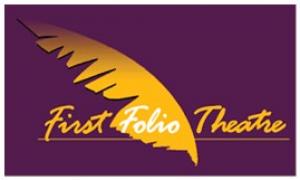
You may have seen a Shakespearean performance in that amazed you with its exciting sword fighting sequences, or an action-packed historical movie that left you wondering how the performers learned such intricate, precise combat routines. So how exactly does one learn the art of stage combat, and how did it begin?
Two performers fight in choreographed stage combat for First Folio Theatre's Henry V, 2019.
- As with many aspects of traditional theater as we know it today, stage combat dates back to the Greek stage and the Roman amphitheater. Fighting was often a form of entertainment, as with the Roman gladiators, but theatrical combat was a way to symbolize combat without causing any real harm to the participants, thus not having to sacrifice citizens.**
- During the Middle Ages, jousts were popular competitive mock combat, and highly specialized equipment was used in an attempt to minimize injuries to competing knights. In the late Middle Ages, staged fencing enabled fights to be choreographed and allowed visually dramatic moves to be enacted for the benefit of the audience.*
A medieval re-enactor performs as a knight in a joust tournament at a Renaissance Faire.
- Richard Tarlton, a member of both William Shakespeare's acting company and of the London Masters of Defence weapons guild, was one of the first fight directors for theater. Before 1615 in England, many plays featured duels, and the duels were the highlights of the show. After 1615, dueling was publicly condemned by King James and the duels were used only as a last resort if the plot needed them.**
- Many of Shakespeare's most beloved plays include stage combat, including Romeo & Juliet, Henry IV, Henry V, Hamlet, MacBeth, King Lear, and many more. These fight sequences often had actors using melee (from the French word mêlée, which refers to disorganized hand-to-hand combat) weapons, which include swords, axes, maces, flails, pikes, and daggers.**
A sword fighting scene from First Folio Theatre's Romeo & Juliet, 2011.
- Stage combat in film as we know it today began in the 1920's when Douglas Fairbanks asked for a fencing master to assist him in his films. Paddy Crean, a celebrated movie fight director, revolutionized stage combat, specifically sword play, for the silver screen and theater. Crean created the flamboyant style of sword play that can be seen in Errol Flynn movies, among others.**
- In the 1940s, martial arts movies emerged as a distinct genre, finally becoming popularized by Bruce Lee and Sonny Chiba in the 1960s.** This style of choreographed combat has become increasingly complex in movies such as The Matrix, Kill Bill, House of Flying Daggers, and many more, which use special effects to heighten the drama of the combat.
What are your favorite choreographed combat from theater or films?
*Information from "What is Stage Combat?" from Swashbuckling Cornwall
**Information from "Stage Combat" from Wikipedia
Our 2020-2021 season is sponsored by Alan and Susan Becker
First Folio's programs are sponsored in part by grants from the Illinois Arts Council (a State agency) and the Gaylord & Dorothy Donnelley Foundation. First Folio Theatre is supported by a grant from the National Endowment for the Arts.
All performances take place on the grounds of the Mayslake Peabody Estate, which is owned and operated by the Forest Preserve District of DuPage County. Indoor shows are presented in Mayslake Hall, a 30-room Tudor Revival style mansion originally built by coal baron Francis S. Peabody. Completed in 1922, the mansion is on the National Registry of Historic Places.
First Folio Theatre is fully accessible with reserved ADA seating available and assisted listening devices available for all indoor performances. To request ADA seating, please contact the Box Office at 630-986-8067.



